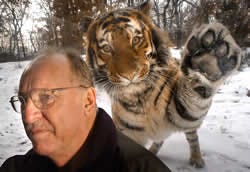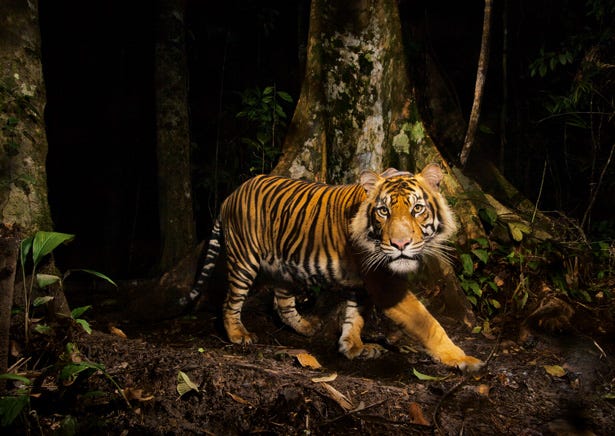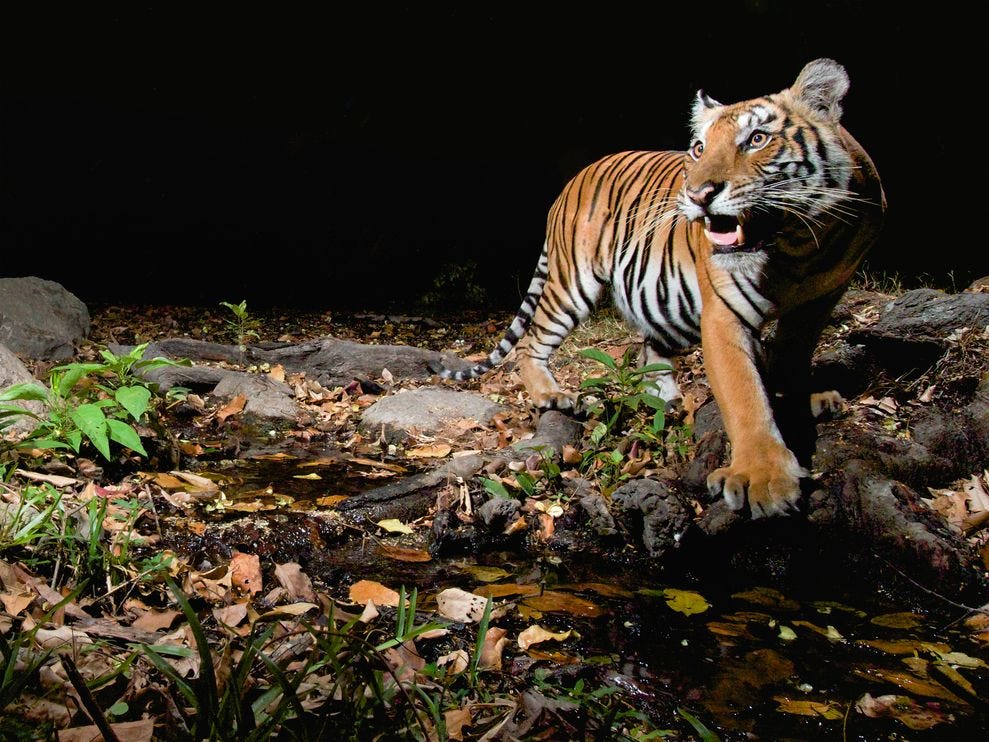Tiger Expert Dr. Ron Tilson Leaves Great Legacy, but Great Cats’ Future to be Determined
By Jordan Schaul | National Geographic | November 24, 2013
In reference to his favorite animals - tigers - Ron Tilson once said, “How can you not be fascinated by an animal like that?” Surely, we are all fascinated by the iconic tiger—the world’s largest cat and Asia’s most dominant, yet endangered predator. We are also fascinated by hard-working field biologists like Ron who have dedicated their lives to...November 24, 2013
In reference to his favorite animals—tigers—Ron Tilson once said, “How can you not be fascinated by an animal like that?” Surely, we are all fascinated by the iconic tiger—the world’s largest cat and Asia’s most dominant, yet endangered predator.
We are also fascinated by hard-working field biologists like Ron who have dedicated their lives to the study and conservation of elusive and imperiled wildlife species like Javan rhinos, Sumatran tigers and Kloss gibbons.
DESPITE RON’S DEDICATION TO SAVING THE GREAT CAT, THE LIVING SUBSPECIES OF THE TIGER, AND MOST NOTABLY, THE SUMATRAN TIGER, COULD EASILY DISAPPEAR IN OUR LIFETIME.
Sadly, Ron passed away on November 16th at his home in Apple Valley, Minnesota. He was 69.
When it came to conserving endangered animals, Ron Tilson, who retired from the Minnesota Zoo two years ago, was a “rock star.” I had the privilege of meeting Ron at a zoo conference in Columbus, OH over a decade ago and remember thinking to myself “this guy is an icon in his own right.”
With his colleague Philip Nyhus, Ron co-edited the second edition of Tigers of the World: The Science, Politics and Conservation of Panthera tigris. This volume, which includes articles by the world’s foremost experts, is the most comprehensive and authoritative reference available on the ecology, conservation, and management of the world’s largest cat.
Dr. Tilson, perhaps the world’s foremost authority on Sumatran tigers, and tiger conservation in general, wasn’t in it for fame or money. He endeavored to save the Sumatran tiger for the sake of the big cat and for future generations of humans to appreciate.
All tiger subspecies are keystone carnivores where they survive in what is left of their historic range. But, frankly, tigers are barely hanging on. Less than 3200 tigers, representing five subspecies, are thought to exist in the wild. The Amur and Malayan subspecies are listed as Endangered by IUCN-The World Conservation Union. The South-China tiger is already extinct in the wild and the Sumatran tiger population is listed as Critically Endangered. Ron fought hard to turn around this negative trend.
Besides fieldwork, Tilson coordinated the Association of Zoos and Aquariums (AZA’s) Tiger Species Survival Plan (SSP), a scientifically-managed, cooperative captive breeding program. As SSP Coordinator Ron worked with colleagues to maintain the genetic diversity of the captive tiger gene pool. In doing so, Tilson ardently opposed the exhibition of white tigers. He argued that the genetic anomaly took up space for tigers of conservation concern and gave the wrong educational message. White tigers are typically hybrids of Bengal tiger and Siberian tigers.
DR. TILSON’S SENTIMENT CHALLENGED THE STATUS QUO, BUT HE WAS RIGHT TO CHALLENGE SUCH ANTIQUATED PRACTICES HARKENING BACK TO THE DAYS OF PT BARNUM.
Since 1984 Dr. Tilson held leadership positions in conservation and science at the Minnesota Zoo and retired as the Zoo’s Vice President of Conservation. Although he claimed to be an “old fashioned field biologist,” he was, in many ways, responsible for making zoos more accountable, not just for the conservation of threatened and endangered species, but also for the preservation of their habitats in nature.
IN FACT, ACCORDING TO MY FRIEND AND COLLEAGUE DR. MICHAEL HUTCHINS, FORMER DIRECTOR/WILLIAM CONWAY CHAIR OF CONSERVATION AND SCIENCE FOR AZA, RON WAS “AT THE VANGUARD OF THE PROFESSIONAL ZOO COMMUNITY’S MOVEMENT TO EMBRACE IN SITU CONSERVATION.
Hutchins, who knew Ron well and traveled with him in Indonesia and co-authored articles with him, said that Ron’s dedication to his work as a field biologist left him with limited tolerance for ineptitude. As a result, he often came off a bit gruff; but, for those that knew him well, he also had a great sense of humor.
Over a beer one evening in Indonesia, Dr. Hutchins recalled a story Ron told that left Hutchins and others in the vicinity in tears from laughter. The burly biologist lived with the local people while conducting his work on gibbons. The primitive toilets the community used were built on bamboo stilts and situated over salt water on the coast. One night, Ron had to use the facilities with some urgency. He rapidly climbed up the ladder and situated himself in the structure. However, being much larger than his hosts, the structure did not support him. The floor literally broke out from underneath him and, after descending through the air, he ended up in the ocean, embarrassed and soaking wet, but not too worse for wear.
Fluent in Bahasa—the official language of Indonesia—Tilson could attribute much of his success to the exceptional relations he cultivated with various local communities, as well as with biologists and local government officials. He was extremely well liked by people from many walks of life. Hutchins recalls how much Ron was respected by Indonesian colleagues and officials, and by people he got to know in Jakarta. One driver that Ron had hired to take him around town went on and on about how he loved Americans. Americans, he said, “treated him like an equal.” Much of this probably had to do with Ron himself, who spoke the language and was aware of local customs. His appreciation for cultural sensitivity could certainly be attributed to his early service in both the Marine Corps. and Peace Corps and undoubtedly prepared him for a career in field conservation in the developing world.
Tilson conducted ecological studies in Southeast Asia dating back to the mid-1970’s. Hutchins recalls that Ron had a traditional tattoo on his forearm of a what we presume was a Kloss or Mentawai gibbon—a species he studied on Siberut Island, which is west of Sumatra. The tattoo was given to him by the local people using traditional methods, which Ron said were quite painful. But this was a great honor, bestowed only upon those who were trusted and respected.
TILSON WAS INSTRUMENTAL IN DEVELOPING THE MINNESOTA ZOO’S ADOPT-A-PARK PROGRAM FOR UJUNG KULON NATIONAL PARK ON JAVA, THE LAST STRONGHOLD OF THE CRITICALLY ENDANGERED JAVAN RHINOCEROS. THE GLOBAL POPULATION OF THIS RARE RHINO WAS ONCE ESTIMATED AT NO MORE THAN 60 INDIVIDUALS.
After attending an IUCN/SSC Captive Breeding Specialist Group planning meeting on Sumatran and Javan rhinos, Hutchins and a small group of AZA colleagues traveled with Ron to the park in the early 1990s to observe what the Zoo was doing. He said, “It was an incredible experience. “We never saw a live rhino,” Hutchins said, “but we did see tracks and felt the presence of this ancient Pleistocene mammal in the region’s thick primeval forests.”
Hutchins recalls that he was amazed at what the zoo was doing to assist the park and the local community, including providing radios to improve communication, building better accommodations for the ranger staff, purchasing a patrol boat (aptly called the “Minnesota”) and assisting the local school. In fact, with Ron’s guidance, the Minnesota Zoo was building one of the first community-based conservation efforts in a developing country—one that served as a model for other zoos as their interest in in situ conservation began to mature.
Ron will be missed, but we should never forget his legacy of zoo-based field conservation and the dedication and innovation he showed on behalf of the wild creatures and habitats he loved.
ABOUT NATIONAL GEOGRAPHIC SOCIETY
The National Geographic Society is a global nonprofit organization that uses the power of science, exploration, education and storytelling to illuminate and protect the wonder of our world. Since 1888, National Geographic has pushed the boundaries of exploration, investing in bold people and transformative ideas, providing more than 14,000 grants for work across all seven continents, reaching 3 million students each year through education offerings, and engaging audiences around the globe through signature experiences, stories and content. To learn more, visit www.nationalgeographic.org or follow us on Instagram, Twitter and Facebook.
MEET THE AUTHOR
Jordan Carlton Schaul With training in wildlife ecology, conservation medicine and comparative psychology, Dr. Schaul's contributions to Nat Geo Voices have covered a range of environmental and social topics. He draws particular attention to the plight of imperiled species highlighting issues at the juncture or nexus of sorta situ wildlife conservation and applied animal welfare. Sorta situ conservation practices are comprised of scientific management and stewardship of animal populations ex situ (in captivity / 'in human care') and in situ (free-ranging / 'in nature'). He also has a background in behavior management and training of companion animals and captive wildlife, as well as conservation marketing and digital publicity. Jordan has shared interviews with colleagues and public figures, as well as editorial news content. In addition, he has posted narratives describing his own work, which include the following examples: • Restoration of wood bison to the Interior of Alaska while (While Animal Curator at Alaska Wildlife Conservation Center and courtesy professor at the University of Alaska) • Rehabilitation of orphaned sloth bears exploited for tourists in South Asia (While executive consultant 'in-residence' at the Agra Bear Rescue Center managed by Wildlife SOS) • Censusing small wild cat (e.g. ocelot and margay) populations in the montane cloud forests of Costa Rica for popular publications with 'The Cat Whisperer' Mieshelle Nagelschneider • Evaluating the impact of ecotourism on marine mammal population stability and welfare off the coast of Mexico's Sea of Cortez (With Boston University's marine science program) Jordan was a director on boards of non-profit wildlife conservation organizations serving nations in Africa, North and South America and Southeast Asia. He is also a consultant to a human-wildlife conflict mitigation organization in the Pacific Northwest. Following animal curatorships in Alaska and California, he served as a charter board member of a zoo advocacy and outreach organization and later as its executive director. Jordan was a member of the Communication and Education Commission of the International Union for the Conservation of Nature (CEC-IUCN) and the Bear Specialist Group of the IUCN Species Survival Commission (BSG-SSC-IUCN). He has served on the advisory council of the National Wildlife Humane Society and in service to the Bear Taxon Advisory Group of the Association of Zoos and Aquariums (AZA Bear TAG). In addition he was an ex officio member of council of the International Association for Bear Research and Management. Contact Email: jordan@jordanschaul.com http://www.facebook.com/jordan.schaul https://www.linkedin.com/in/jordanschaul/ www.jordanschaul.com www.bicoastalreputationmanagement.com






